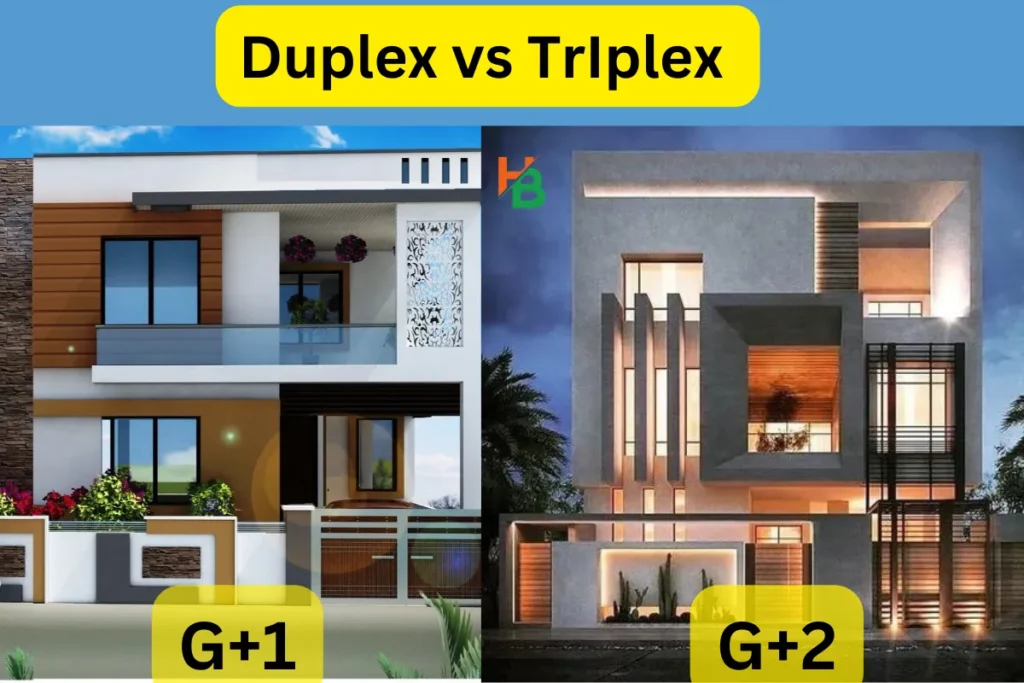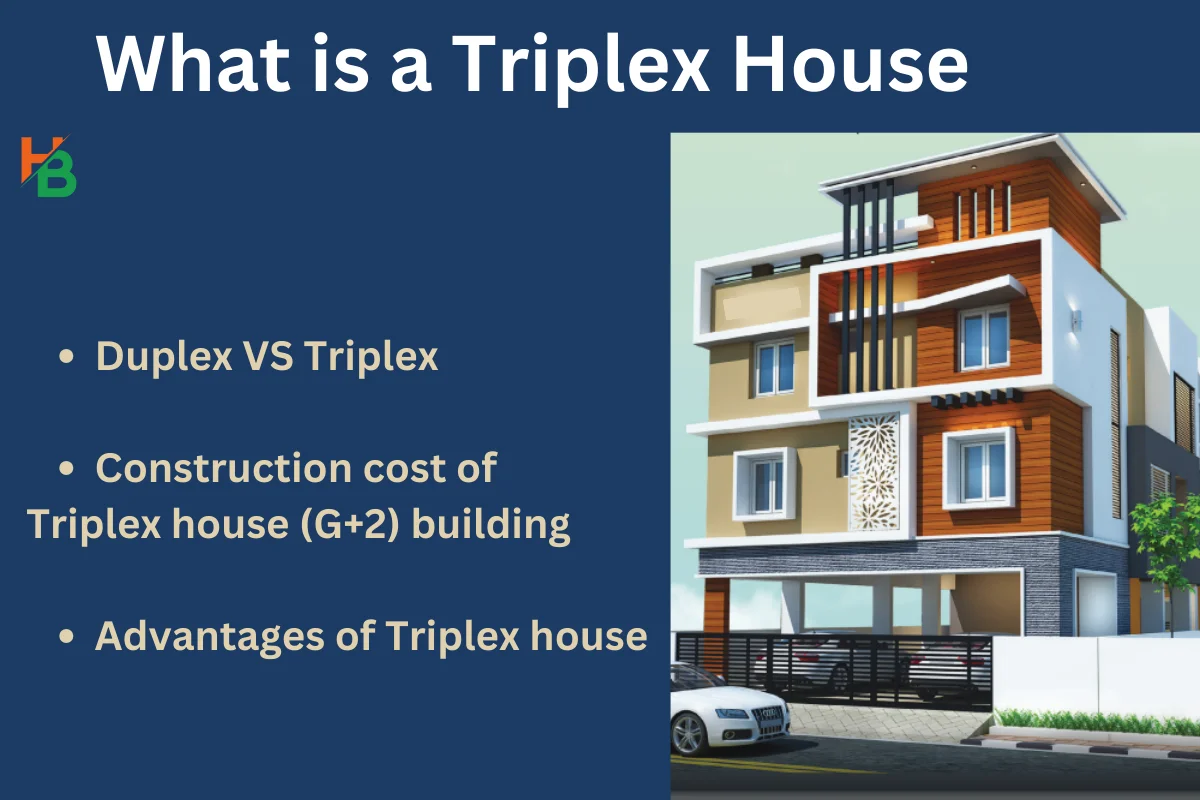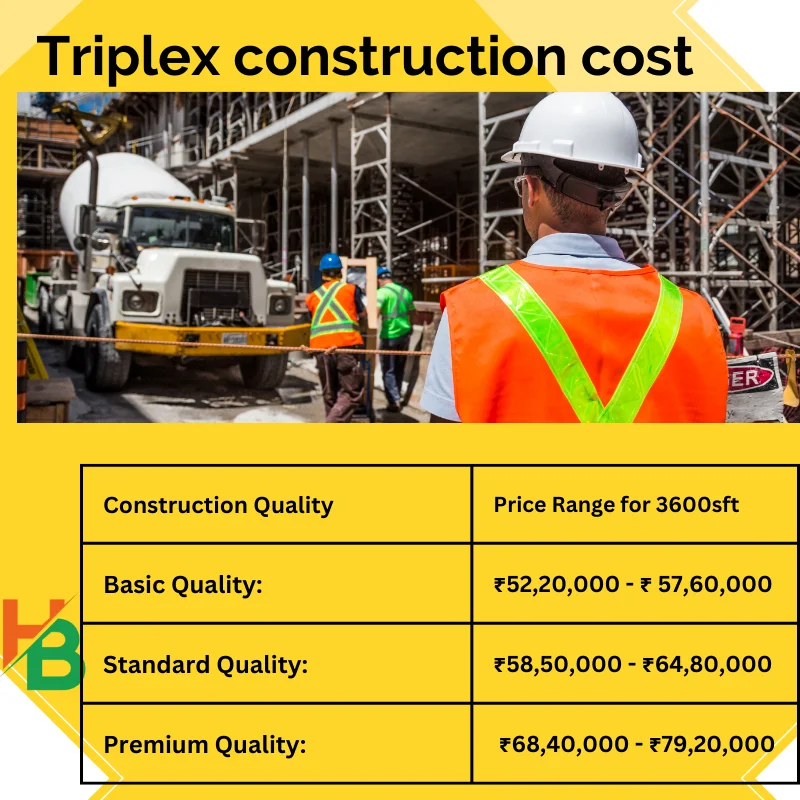What is Triplex House
Table of Contents
ToggleA triplex building is a type of residential building that consists of three individual living units within a single structure, often called as G+2 building. These units are typically self-contained, each equipped with their own essential facilities like bathrooms, kitchens, and living areas. One of the defining features of a triplex apartment is that the units often share one or two common walls, making them distinct from completely detached houses.
The design and layout of triplex apartments can vary significantly. In some cases, a triplex might start its life as a single-family home and later be converted into a three-unit building. This conversion can result in some unique architectural features. For instance, you might encounter a triplex where a one-bedroom unit is distributed over two floors, linked by a half-staircase. This kind of design is more likely to be seen in buildings where each floor is higher than the standard height, giving enough vertical space to accommodate such a layout.
This arrangement offers a blend of communal and private living spaces within the same building, making triplex apartments a versatile option for a variety of living situations. Whether for families seeking proximity yet privacy, or investors looking for a multi-unit property with distinct character, triplex apartments present a unique housing solution.
According to indiahousing report 95% of rural households own their homes, only 69% of urban households do, largely due to the high number of migrants in cities. The 2011 Census data shows variation in urban house ownership across different states and city sizes, with lower ownership in larger cities.
What it Means to Triple house development?
- Urban Migration and Housing Demand: The high rate of urban migration mentioned in the article increases the demand for various types of housing in cities, including triplex houses. Migrants often look for affordable and flexible housing options, which can make multi-unit buildings like triplexes appealing.
- Ownership vs. Rental: The distinction between owned and rented households in the article suggests a market for both owned and rented units in triplexes. Some people may prefer to own one unit in a triplex, while others might rent, reflecting the diverse housing needs in urban areas.
- Household Size and Configuration: The article notes that the average household size in rented accommodations is smaller. This could influence the design and size of units in triplex houses, with smaller units being more suitable for renters, particularly migrants who might live alone or with fewer family members.
- Affordability and Housing Choices: The mention of affordability issues in urban areas could be particularly relevant for triplex houses. Given their structure, triplexes can be a more affordable option for both renters and buyers, fitting into the urban housing market where there’s a demand for diverse price points.
- Urban Planning and Housing Policy: The patterns of house ownership and the role of migration in urban areas, as discussed in the article, could influence urban planning and housing policies. This might affect the development of triplex housing, especially in terms of location, density regulations, and investment incentives.
Duplex vs Triplex
Duplex
- Number of Units: A duplex consists of two separate living units. These units can be side-by-side or stacked one above the other.
- Ownership: Often, both units in a duplex can be under a single ownership, but they can also be split into two separate properties with different owners.
- Privacy: Duplexes offer more privacy than apartment complexes as there are only two units. However, each unit shares a common wall (in side-by-side layouts) or a floor/ceiling (in stacked layouts).
- Size and Design: Duplexes typically resemble a single-family home split into two units. Each unit may have its own entrance, amenities, and utilities.
- Investment and Rental Potential: A duplex can be a good investment for those looking to live in one unit and rent out the other, thereby offsetting mortgage costs.
- Cost: Generally, the cost of buying or building a duplex is less than a triplex due to the smaller size and fewer units.
Triplex
- Number of Units: A triplex contains three separate living units. These can be arranged side-by-side, stacked, or in a combination of both.
- Ownership: Like duplexes, triplexes can be under a single ownership, which is common for investment purposes, or divided into individually owned units.
- Privacy: Triplexes typically offer more privacy than larger apartment buildings but less than single-family homes. They also involve shared walls or floors/ceilings between units.
- Size and Design: Triplexes are larger than duplexes and may have varied designs, ranging from simple to complex layouts. Each unit generally has independent access and separate amenities.
- Investment and Rental Potential: With three units, a triplex can offer higher rental income potential. It is suitable for those looking to expand their investment in real estate.
- Cost: The construction or purchase cost of a triplex is typically higher than that of a duplex due to more units, larger size, and potentially more complex design.

Key Differences between Duplex and Triplex
| Feature | Duplex | Triplex |
|---|---|---|
| Units | Two separate living units | Three separate living units |
| Ownership | Single or split ownership | Often under a single ownership |
| Privacy | More than apartments, less than single homes | Moderate, with shared walls or floors |
| Size & Design | Resembles split single-family home | Larger, more complex layouts |
| Investment Potential | Suitable for dual rental or owner-occupancy | Higher rental income with three units |
| Cost | Generally less than a triplex | Higher due to more units |
The Appeal of Triplex Apartments
Varied Styles
Triplexes come in various designs, with the most sought-after being those where each unit has a similar floor area. These spacious interiors, reminiscent of house-like living, are particularly appealing to families.
Ownership and Investment
A triplex is typically sold as a single entity. Owners may choose to live in one unit and rent out the others, or rent all three for income generation. This flexibility makes triplexes a popular choice for investors and multi-generational families alike.
Internal Connectivity and Stairway Designs
Triplex buildings are unique in their architectural design, particularly in how the individual units are connected internally. Here’s a closer look at two key aspects of their design:
Triplex Houses Connectivity
- Internal Connectivity Staircase: This is the most common design in residential triplexes. The staircase is located inside the building, providing direct and private access to all three floors. This design is preferred for single-family homes or when the triplex is designed to be used by one family or unit. It offers privacy and security, as access to the upper floors is controlled through the main entrance of the building.
- External Connectivity Staircase: This is the most common triplex building in India, especially in multi-family buildings or rental units, external staircases might be used. This design has staircases outside the building, often at the back or side. Each floor might have its own external entrance, which is accessible via the staircase. This setup is beneficial when each floor of the triplex is meant to function as a separate unit, like in rental properties. It offers more privacy and independence to each unit.
Stairway Designs
- Spiral Stairs: These are a popular choice in triplexes where saving space is crucial. Spiral staircases add a modern and artistic touch while efficiently connecting the different levels.
- Switch-Back Stairs: This design is more traditional and features a straight stairway with a landing before changing direction. It’s practical for moving between floors and can accommodate more foot traffic.
- Floating Stairs: Known for their aesthetic appeal, floating stairs give a sense of openness and light. They are designed with treads without visible risers, giving the illusion that they are ‘floating.’
Construction Cost of G+2 30×40 House (Triplex House)
If you have a 30×40 plot, which amounts to 1200 square feet (since 30 feet by 40 feet equals 1200 square feet), and you are planning to build a G+2 (ground plus two floors) triplex house, the total built-up area would be calculated by multiplying the area of each floor with the number of floors.
- Each floor is 1200 square feet.
- There are three floors in total (Ground floor, First floor, and Second floor).
- So, the total built-up area would be 1200 square feet (per floor) multiplied by 3 (floors), which equals 3600 square feet.
Factors Influencing Triplex construction cost
- Location: Costs can vary significantly depending on the location of your property. Urban areas typically have higher costs due to the cost of land and higher labor rates, while rural areas may have lower costs but could incur extra expenses for transportation of materials.
- Size of the Plot and Built-Up Area: The total area of construction directly impacts the cost. Larger plots and areas with more built-up space will require more materials and labor, increasing the overall cost.
- Layout and Design: The complexity of the design also plays a significant role. A complex design with multiple features, custom elements, or unique architectural requirements will cost more than a simpler, more standard design.
- Construction Materials: The type of materials used can greatly affect the cost. High-quality, durable materials are more expensive but can offer better longevity and lower maintenance costs in the long run.
- Finishes: The type of finishes you choose for flooring, walls, ceilings, and fittings can significantly impact the budget. Luxury finishes and high-end materials will drive up costs.
- Weather Considerations: If your construction site is in an area with extreme weather conditions, this could impact the type of materials and construction methods used, potentially affecting the cost.
- Builder Type: Whether you’re working with a small, local builder or a large construction firm can influence costs. Large builders may offer economies of scale, but small builders can provide more personalized services, sometimes at a more affordable rate.
- Labor Costs: These can vary widely depending on the region and the skill level of the workers required. Specialized labor for certain aspects of construction can be more expensive
Pros and Cons of Owning a Triplex
Benefits of Owning a Triplex
- Proximity for Landlords: Living in one of the units or being close to the property allows for easier management and quicker response to repairs and maintenance issues.
- Tax Deductions: Owners can often claim deductions for expenses related to the maintenance and repair of the rental units, which can lead to tax savings.
- Efficiency in Shared Features Management: Shared areas like yards and roofs mean that maintenance can be more centralized and potentially more cost-effective than managing separate properties.
- Rental Income Potential: Owning a triplex offers the opportunity to generate significant rental income. If the owner lives in one unit, the rent from the other two can contribute to or even cover the mortgage and other expenses.
Drawbacks of Owning a Triplex
- Higher Acquisition Costs: Triplexes typically have a higher initial purchase price compared to duplexes or single-family homes, owing to their larger size and the additional unit.
- Resale Challenges: Selling a triplex can be more complex than selling a single-family home due to the presence of multiple tenants and varying lease terms.
- Potential for Tenant-Related Stress: Living in close proximity to tenants may lead to increased interactions and potential conflicts, which can be a source of stress for some landlords.
- Market Availability: Triplexes are generally less common than duplexes or single-family homes, making them harder to find and possibly limiting options for those specifically seeking this type of property.
The Triplex Living Experience: Amenities, Privacy, and Investment Opportunities
What is the Standard Size of a Triplex Building?
Design and Layout: The size of a triplex also depends on its design. Some triplexes have three relatively small and compact units, while others might have larger, more spacious units. The number of bedrooms, bathrooms, and additional spaces like living rooms, kitchens, and dining areas will also affect the overall size.
Typical Sizes: In general, each unit in a triplex might range from as small as 700 square feet to as large as 2,000 square feet or more, depending on the factors mentioned above. Therefore, the total built-up area of a triplex could be anywhere from 2,100 square feet (G +2 building) to 6,000 square feet or more (for three large units).
Amenities in a Triplex
- Home-Like Features: Triplexes often come equipped with amenities that elevate the living experience to be more akin to a single-family home. This includes in-unit laundry facilities, providing convenience and privacy.
- Outdoor Spaces: Many triplex units feature personal outdoor spaces such as patios or small yards, offering residents their own private area to relax and entertain.
- Garage Access: Depending on the design and location, some triplexes come with garages or dedicated parking spots, a significant advantage in urban areas where parking can be a challenge.
Privacy and Space
- Enhanced Privacy: With only two other units in the structure, triplexes inherently provide more privacy than larger apartment complexes. This setup is particularly appealing for those who prefer a quieter living environment.
- Spaciousness: Generally, each unit in a triplex is larger than a standard apartment, offering more living space. This makes them ideal for families or anyone needing extra room for work or leisure activities.
- Outdoor Area: The limited number of units in a triplex often means more generous outdoor space shared among fewer residents, enhancing the sense of exclusivity and tranquility.
Ideal Investment Gateway
- Easier Management: Managing a triplex can be simpler than handling a larger multifamily property. This is particularly beneficial for those transitioning from managing a single-family home.
- Tenant Screening and Interaction: With fewer units to rent out, landlords can be more selective and thorough in their tenant screening process. Additionally, having fewer tenants can make for easier, more personal interactions and potentially smoother management.
- Stepping Stone in Real Estate: For investors, a triplex serves as an excellent intermediary step between single-family homes and larger apartment complexes. It offers a taste of managing a multi-unit property without the complexity of a large-scale operation.
Triplex Financing
- Residential vs. Commercial Loans: Triplexes qualify for residential mortgage loans, offering more favorable terms than commercial loans required for larger properties. Residential loans offer lower interest rates and longer amortization periods, making them more attractive for real estate investors.
Conclusion
Triplex apartments offer a unique blend of benefits for a diverse range of needs, from family living to real estate investment. However, they also come with their own set of challenges, including higher costs and maintenance responsibilities. For those considering a triplex, it’s important to weigh these factors to make an informed decision that aligns with your personal and financial goals.





